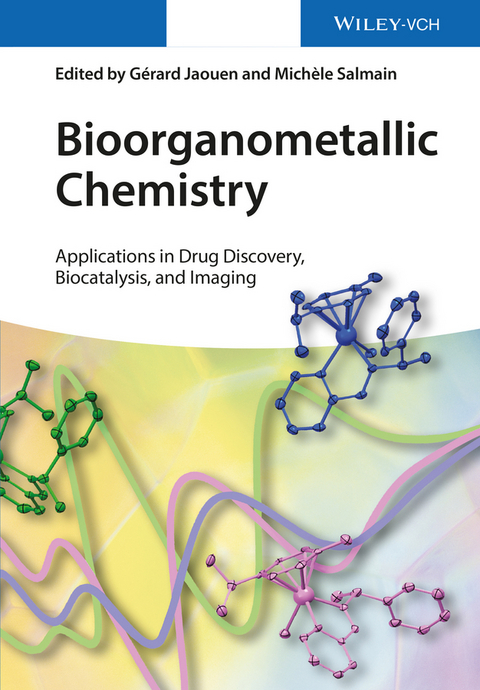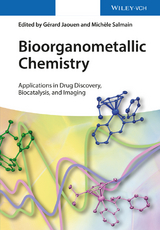Bioorganometallic Chemistry
Wiley-VCH (Verlag)
978-3-527-33527-5 (ISBN)
- Titel ist leider vergriffen;
keine Neuauflage - Artikel merken
Gérard Jaouen obtained his PhD degree in organic chemistry at the University of Rennes, France, in 1969. From 1973 to 1974 he did postdoctoral studies at the University of Cambridge, UK, working with the late Professor (Lord) Jack Lewis. He became a member of the CNRS in 1970, was appointed Directeur de Recherche in 1976 and became Professor at the École Nationale Supérieure de Chimie in Paris in 1982, where in 1984 he set up a CNRS associated research unit. He is now appointed as a "classe exceptionnelle" professor. He is the author of more than 400 papers and holds 14 patents. His achievements in bioorganometallic chemistry have been recognized by several awards. He was awarded "Chevalier dans l'ordre de la Légion d'Honneur" (Knight of the National Order of the Legion of Honour, 2006) and elected as a fellow of the European Academy of Sciences and a member of the Academia Europae in 2012. Michèle Salmain received her PhD degree in organic chemistry from the Université Pierre et Marie Curie, Paris, France in 1990. She has been appointed as a researcher by the Centre National de la Recherche Scientfique (CNRS) since 1992 and currently holds position of Directeur de Recherche. Since the beginning of her academic career, her line of research has lied in the field of bioorganometallic chemistry. Her current interests are focused on the design of immunosensors for analytical applications and artificial metalloenzymes for enantioselective catalysis application
Preface
PART I: Medicinal Chemistry
ORGANOMETALLIC COMPLEXES AS ENZYME INHIBITORS: A CONCEPTUAL OVERVIEW
Introduction
Organometallic Compounds as Inert Structural Scaffolds for Enzyme Inhibition
Organometallic Compounds Targeting Specific Protein Residues
The Bioisosteric Substitution
Novel Mechanisms of Enzyme Inhibition with Organometallic Compounds
Organometallic Compounds as Cargo Delivers of Enzyme Inhibitors
Organometallic Enzyme Inhibitors for Theranostic Purposes
Conclusion
THE BIOLOGICAL TARGET POTENTIAL OF ORGANOMETALLIC STEROIDS
Introductory Note on Nuclear Receptors
Steroids and Organometallics: An Overview of the Transitional Period from the Use of Organometallics in Synthesis to the Emergence of Bioorganometallics
Epilog
CHIRALITY IN ORGANOMETALLIC ANTICANCER COMPLEXES
Introduction
Chirality in Arene Complexes
CIP System for the Nomenclature of Chiral-at-Metal Arene Complexes
Chiral Organometallic Complexes as Anticancer Agents
Half-Sandwich Complexes with Chiral Metal Centers
Conclusions
GOLD ORGANOMETALLICS WITH BIOLOGICAL PROPERTIES
Introduction: The Use of Gold in Medicine
Anticancer Gold Organmetallics and Proposed Biological Targets
Conclusions and Perspectives
ON THE MOLECULAR MECHANISMS OF THE ANTIMALARIAL ACTION OF FERROQUINE
History and Development
Mechanism(s) of Action 4-Aminoquinoline Antimalarials
Mechanism(s) of Action of Ferroquine as an Antimalarial
Conclusion
METAL CARBONYL PRODRUGS: CO DELIVERY AND BEYOND
Introducing CO in Biology
Therapeutic Delivery of CO
Biological and Therapeutic Results Obtained with the Early-Stage CORMs
Beyond the Early-Stage CORMs: Strategies for Finding New Candidates
Intracellular Detection of CORMs, Mechanistic Studies, and Other Unanswered Questions
Designing Pharmacologically Useful, Drug-like CORMs
Final Remarks and Perspectives
DINITROSYL IRON COMPLEXES WITH NATURAL THIOL-CONTAINING LIGANDS: PHYSICOCHEMISTRY, BIOLOGY, AND MEDICINE
Introduction
The History of Detection and Identification of DNIC with Thiol-Containing Ligands in Microorganisms and Animal Tissues
Physicochemistry of DNIC with Natural Thiol-Containing Ligands
Biological Effects of DNIC with Thiol-Containing Ligands
DNIC with Thiol-Containing Ligands as a Basis in the Design of Drugs with a Broad Range of Therapeutic Activities
PART II: Metalloproteins, Catalysis, and Energy Production
THE BIOORGANOMETALLIC CHEMISTRY OF HYDROGENASE
Introduction
Structure and Function
Natural Biosynthesis and Synthetic Analogs of the Active Sites
Comments and Conclusion
BIO-ORGANOMETALLIC SYSTEMS FOR THE HYDROGEN ECONOMY: ENGINEERING OF ELECTRODE MATERIALS AND LIGHT-DRIVEN DEVICES
Introduction
Electrode Materials for Hydrogen Evolution and Uptake
Light-Driven Systems for Hydrogen Evolution
Artificial Photosynthetic Systems
Summary and Conclusions
ARTIFICIAL METALLOENZYMES CONTAINING AN ORGANOMETALLIC ACTIVE SITE
Introduction
Dative Anchoring
Supramolecular Anchoring
Covalent Anchoring
Mixed Anchoring Modes
Peptide Scaffolds
Summary and Outlook
PART III: Bioanalysis
ORGANOMETALLIC BIOPROBES FOR CELLULAR IMAGING
Introduction
Luminescence
Vibrational Spectroscopy
Miscellaenous
Conclusions
Index
| Erscheint lt. Verlag | 28.1.2015 |
|---|---|
| Sprache | englisch |
| Maße | 170 x 244 mm |
| Gewicht | 1070 g |
| Themenwelt | Naturwissenschaften ► Chemie ► Organische Chemie |
| Schlagworte | Bioanorganische Chemie • Biochemie • Biochemie u. Chemische Biologie • Biochemistry (Chemical Biology) • Chemie • Chemistry • Coordination Chemistry • Koordinationschemie • Medizinische Chemie • Metallorganische Verbindungen • Organometallchemie • Organometallic Chemistry • Pharmaceutical & Medicinal Chemistry • Pharmaceutical & Medicinal Chemistry • Pharmazeutische u. Medizinische Chemie |
| ISBN-10 | 3-527-33527-7 / 3527335277 |
| ISBN-13 | 978-3-527-33527-5 / 9783527335275 |
| Zustand | Neuware |
| Haben Sie eine Frage zum Produkt? |
aus dem Bereich




